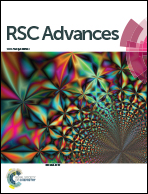Facile synthesis of sheet-like N–TiO2/g-C3N4 heterojunctions with highly enhanced and stable visible-light photocatalytic activities†
Abstract
Sheet-like N–TiO2/g-C3N4 heterojunctions with well-controlled structures as high-efficiency visible-light photocatalysts were synthesized by direct co-calcination of preformed N–TiO2 nanoparticles and g-C3N4 nanosheets. The composition, structure, morphology, and optical absorption properties of the as-prepared g-C3N4 nanosheets and N–TiO2/g-C3N4 heterojunctions were thoroughly investigated with XRD, FT-IR, SEM, TEM, XPS, and UV-vis DRS, respectively. The visible-light photocatalytic activity of the heterojunctions with different N–TiO2/g-C3N4 mass ratios was evaluated by photodegradation of rhodamine B dye and the highest enhancement was attained at a mass ratio of 1 : 3, which was 19 and 5.3 times as high as that of the individual N–TiO2 nanoparticles and g-C3N4 nanosheets, respectively. The photocatalytic activity of the composites originating from nanosheets is 11 times as high as that of the bulk g-C3N4/N–TiO2 heterojunctions. Moreover, the sheet-like N–TiO2/g-C3N4 photocatalyst exhibits excellent stability against repeated use and could still retain over 98.8% of the initial activity after seven cycles. Such a good visible-light photocatalytic performance is mainly due to the effective structure and chemical composition provided by the present method, which endow the as-prepared heterojunctions with exceptionally high specific surface area (>80 m2 g−1) as well as efficient charge transfer at the heterojunction interfaces. The charge separation mechanism during the photodegradation process was also studied and a possible photocatalytic mechanism was proposed.


 Please wait while we load your content...
Please wait while we load your content...